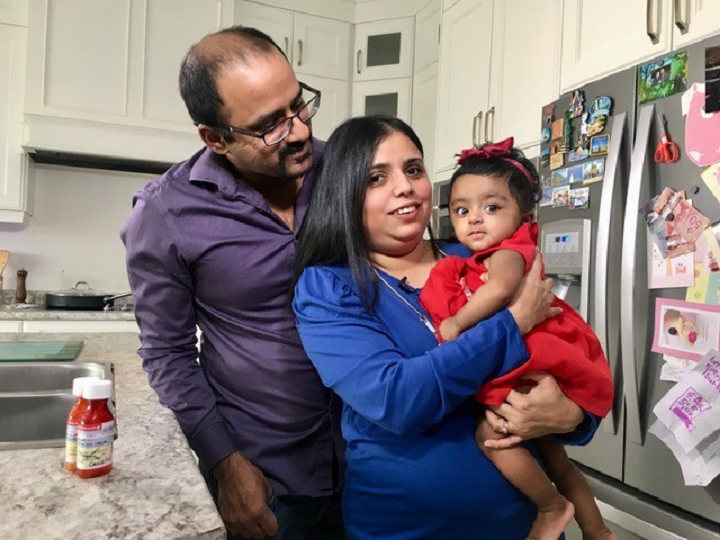Omayma Pathan says she will never trust another pharmacy again after she alleges her local Shoppers Drug Mart misfilled her daughter’s anti-reflux medication prescription with a powerful opioid.

“I was given a full bottle of methadone — basically a legal substitution for heroin,” she told Global News.
Pathan, a first-time mother to five-month-old Maryum, said she had been to the Shoppers Drug Mart location at Chinguacousy Road and Queen Street West three times prior to fill her daughter’s anti-reflux medication. But it was during the fourth visit that she said she was instead given the opioid.
“This was a pharmacist I trusted,” she explained.
“Even if I gave her a few drops, this could have killed her.”
The head of the emergency department at North York General Hospital told Global News that Pathan’s belief isn’t wrong. If an infant of Maryum’s age were to take methadone, the consequences could be devastating.
“At a minimum they would be sedated — really, really drowsy — but even in small volumes, it could definitely be fatal. It would not take very much,” Dr. Paul Hannam said.
Hannam said methadone is often used as a tool to combat the opioid crisis.
“It would be considered life-saving when given to the right population … but it would 100 per cent be an emergency situation if an infant were to ingest this drug.”
Pathan said to make matters worse, the directions on the bottle prescribed all of the contents.
“Luckily I was literate enough to read, but in Brampton there are a lot of people who can’t read and write English. Can you imagine what would have happened?” she asked.
“When you go to a Shoppers, when you get a bottle of something, you don’t always read it.”
Global News contacted the Shoppers Drug Mart location where Pathan filled the prescription. The owner of the pharmacy, Raina Hanna, said she had no comment at the time, referring Global News to head office.
A statement from the corporate office said in part, “We share the view that this is a considerable error, and one that absolutely should not have happened. We have been in constant contact with the family to apologize, address their concerns and answer any questions. We have many controls and processes in place to protect patients. This was a case of human error, one that we do not take lightly.”

Get weekly health news
The company said they are in the process of “reinforcing” procedures to ensure something like this does not happen again.
Pathan said she has also been in touch with the pharmacy giant. She said while she and her husband are “traumatized” by the incident, they are pleased the company is now investigating.
“They seem to be taking it seriously,” Pathan said, adding she hopes the pharmacist in question will receive extra training.
This is not the first time a child’s prescription has been misfilled by an Ontario pharmacy.
In 2016, an eight-year-old Mississauga boy died after ingesting the wrong medication.
“We had no idea this could even happen,” Andrew’s mother, Melissa Sheldrick, told Global News in March of that year.
A coroner’s report revealed the bottle of medication Sheldrick picked up from a Mississauga pharmacy didn’t contain Tryptophan, the sleeping drug Andrew had been prescribed. Instead, the report indicated he ingested a toxic level of Baclofen — a muscle relaxant.
In November 2018, the Ontario College of Pharmacists (OCP) implemented a program to track any mistakes.
Dubbed the Assurance and Improvement in Medication Safety program, it required medication incidents to be recorded into an independent third-party database “to better support shared learning and further promote quality improvement.”
In response to Global News’ request for information, OCP revealed a summary of the program’s outcome thus far.
According to the latest data, over a 15-month period — February 2018 to May 1 2019 — there were 4,426 “medication events” at the pharmacies in Ontario enrolled in AIMS.
That works out to around 300 incidents per month.
OCP would not say exactly how many pharmacies its preliminary report included, pointing out, only, that it ranged from 100-2700 during the dates mentioned.
Of these reported cases, in 46 per cent, the medication reached the patient.
None of the events reported were fatal, however, 148 were listed to have harm levels ranging from mild to severe.
Almost half of the cases were due to incorrect strength or incorrect drug.
AIMS found reasons for the medical incidents included environmental, staffing or workflow issues, a lack of quality control or independent check system, or a lack of education and “other contributing factors.”
As of August, approximately 3,600 of the province’s 4,500 have enrolled in AIMS.
The Dean of the College of Pharmacy at the University of Cincinnati, Neil MacKinnon, says while AIMS is quite new, this report shows Canada is “a world leader in medical incident reporting.”
“The information collected as part of these reports should lead to a safer medication-use system,” MacKinnon told Global News.
Pathan, meanwhile, says she wants to use her daughter’s incident to remind other parents to double check their children’s medication.
“God knows what the next morning would have brought us. This is the only child we have … our lives would have been shattered if I didn’t read the actual bottle,” she said, noting she’s grateful she took a double take, but is fearful for other families.









Comments